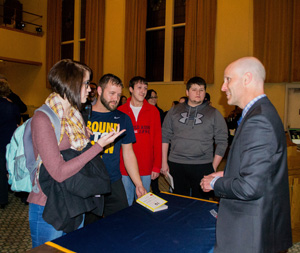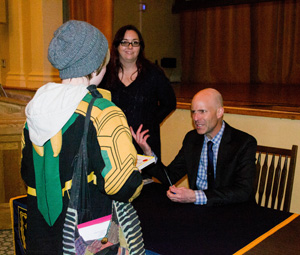Story by Mikayla Marshall, Staff writer

Daniel Simons presented his research, “Missing What’s Missing,” during the Dr. and Mrs. Gary Brummer Colloquium Series in Psychology.
The Dr. and Mrs. Gary Brummer Colloquium Series in Psychology welcomed Daniel Simons Thursday, Feb. 11, to present “Missing What’s Missing.”
The presentation revolved around the idea that the human mind misses more details than the average person may think. The experiences humans have on a daily basis can be misleading, fostering illusions about cognitive abilities and delusions about the richness of understanding.
“There is usually a finding of over-confidence, and the people who are the most over-confident tend to be the least capable,” said Simons, a visual cognition researcher.
Simons is co-author of the book “The Invisible Gorilla: And Other Ways Our Intuitions Deceive Us.” The book focuses on improving previous studies on the topic and discovering how much people cognitively miss in everyday occurrences.
In one experiment they completed, a man asked another man for directions. In the middle of giving directions, two men walk in between them with a wooden board. The man giving directions continues to explain but does not notice that the man he was giving directions to is a completely different man.
The most recognizable experiment of Simons’ study is the “Monkey Business Illusion.”

In the video, there are three basketball players in white shirts and three in black shirts. The audience is supposed to count how many passes are made between the basketball players in white.
At the end, the audience counted 16 passes, but most miss the person in a gorilla suit walking through and banging on his chest for nine seconds.
Simons plans to continue this work and see if there are individual factors within people that cause them to miss certain occurrences. He wants to see if some people notice more than others. So far, the only factor discovered is age, with younger people noticing their surroundings more.
“He is one of the leading visual cognition researchers out there,” said Eric Smith, associate professor of psychology.
Smith said he admires Simons’ work with ethics and how his work teaches educators how they can improve in their field. He said there has been controversy in the psychology field regarding replication of others’ work and Simons’ work helps by updating and furthering his research.
“It was very fascinating,” said Bree Lowrance, sophomore from Smithland, Kentucky. “It was really eye-opening to see how much we miss on a day-to-day basis.”
She said that the presentation was entertaining because Simons demonstrated his work in a relatable way.
Simons said he enjoys presenting his work. He said his favorite part is the questions because he gets to see what viewers take away from the presentation and he gets to hear different insights.
The Dr. and Mrs. Gary Brummer Colloquium Series is an annual series and will continue to host speakers for the rest of this year and begin again next year. The next speaker will be Wayne Weiten, professor at University of Nevada – Las Vegas, discussing popular myths about psychological research.